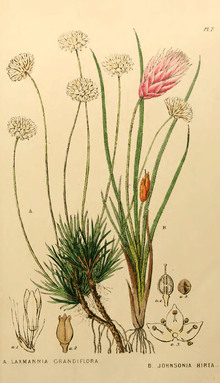Laxmannia
| Laxmannia | |
|---|---|
 | |
| Laxmannia grandiflora 1839 illustration[1] | |
| Scientific classification | |
| Kingdom: | Plantae |
| Clade: | Angiosperms |
| Clade: | Monocots |
| Order: | Asparagales |
| Family: | Asparagaceae |
| Subfamily: | Lomandroideae |
| Genus: | Laxmannia R.Br. |
| Synonyms[2] | |
|
Bartlingia F.Muell. ex Benth. 1878, illegitimate homonym, not Rchb. 1824 nor Brongn. 1827 | |
Laxmannia is a genus of tufted perennial herbs in the family Asparagaceae, subfamily Lomandroideae,[3] that are endemic to Australia.[4]
- Laxmannia arida Keighery - WA, NT
- Laxmannia brachyphylla F.Muell. – Stilted Paper-Lily[6] - WA
- Laxmannia compacta Conran & P.I.Forst. - NSW, Qld
- Laxmannia gracilis R.Br. – Slender Wire-lily[4] - NSW, Qld, Vic
- Laxmannia grandiflora Lindl. - WA
- Laxmannia jamesii Keighery – Paperlily[6] - WA
- Laxmannia minor R.Br. - WA
- Laxmannia morrisii Keighery - Tas
- Laxmannia omnifertilis Keighery - WA
- Laxmannia orientalis Keighery – Dwarf Wire-lily[7] - SA, Vic, Tas
- Laxmannia paleacea F.Muell. - WA
- Laxmannia ramosa Lindl. – Branching Lily[6] - WA
- Laxmannia sessiliflora Decne. - WA
- Laxmannia squarrosa Lindl. – Nodding Lily[6] - WA
References
- ↑ from A sketch of the vegetation of the Swan River Colonyby John Lindley. The plants depicted are Laxmannia grandiflora and Johnsonia hirta (now Johnsonia pubescens).
- ↑ 2.0 2.1 Kew World Checklist of Selected Plant Families
- ↑ Chase, M.W.; Reveal, J.L. & Fay, M.F. (2009), "A subfamilial classification for the expanded asparagalean families Amaryllidaceae, Asparagaceae and Xanthorrhoeaceae", Botanical Journal of the Linnean Society 161 (2): 132–136, doi:10.1111/j.1095-8339.2009.00999.x
- ↑ 4.0 4.1 "Genus Laxmannia". PlantNET - New South Wales Flora Online. Royal Botanic Gardens & Domain Trust, Sydney Australia. Retrieved 2009-04-19.
- ↑ "Laxmannia". Australian Plant Name Index (APNI), IBIS database. Centre for Plant Biodiversity Research, Australian Government, Canberra. Retrieved 2009-04-19.
- ↑ 6.0 6.1 6.2 6.3 "Laxmannia". FloraBase. Department of Environment and Conservation, Government of Western Australia.
- ↑ Corrick, M.G. and Fuhrer, B.A. (2001). Wildflowers of Victoria and adjoining areas. Australia: Bloomings Books. ISBN 1876473142.